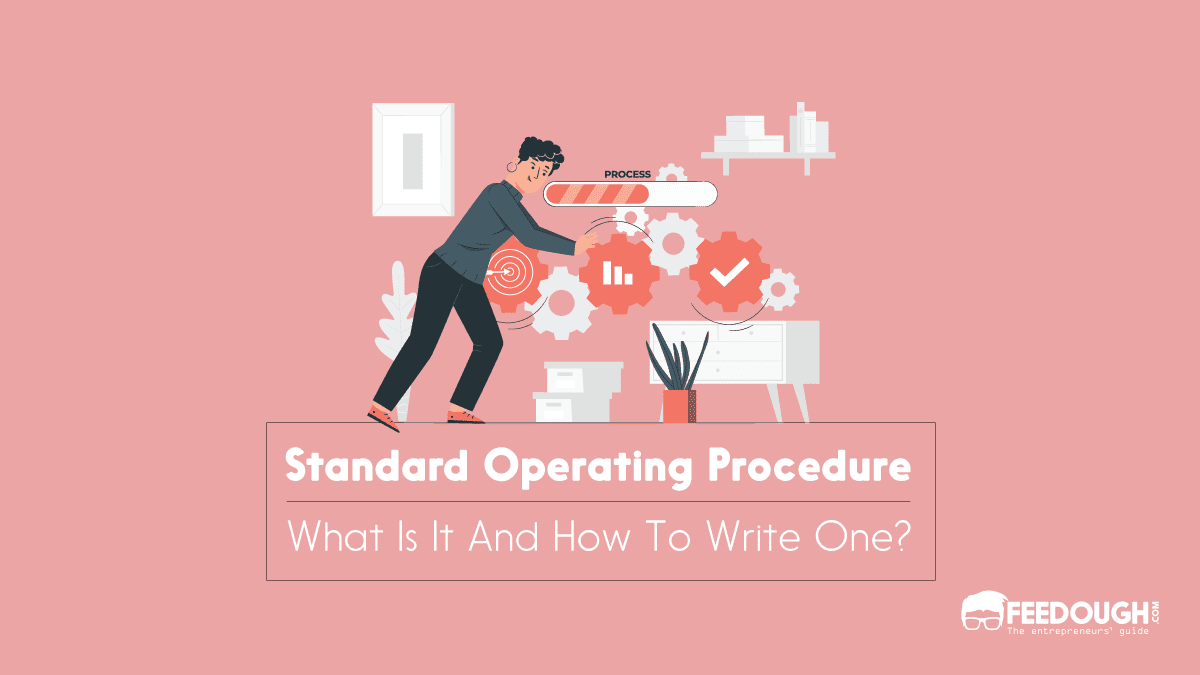SOP is a written term that has been used for decades in the field of science to describe any procedure commonly followed by a group of people to achieve a goal. Nowadays, a standard operating procedure (SOP) is an important tool for managers who need to define their processes and those responsible for training others.
A good SOP helps leaders save time and money so that they can focus on what’s important.
But what is a standard operating procedure, what is it used for, and how to write one?
Here’s a guide.
What is a Standard Operating Procedure?
A standard operating procedure (SOP) is a written step-by-step description of a process or procedure intended to be followed repeatedly.
The main purpose of writing an SOP is to standardise the way to do a routine activity so that everyone who follows it knows what to expect. It makes training easier and reduces the risk of errors.
SOP outlines the policies, processes, and standards followed by people carrying out an activity in a given situation. It is usually written as a series of steps. Each step represents one action that needs to be performed to achieve a specific goal.
Benefits And Importance Of Standard Operating Procedure
SOPs save time and reduce errors. They can also help prevent conflicts between people who need to cooperate with each other.
Moreover, having an SOP:
- Helps control product quality and consistency: Having an SOP reduces the possibility of missed steps or other errors that could affect the quality of the product.
- Saves time and money during training: When new employees are properly trained, they are less likely to make mistakes that can waste time and resources.
- Facilitates better communication between team members: By having a common understanding of how things should be done, team members can communicate more effectively with each other.
- Ensures safety: Following an SOP while performing a task can help minimise the risk of accidents or injuries.
- Protects from knowledge loss: A properly written SOP can help maintain knowledge that might otherwise fade over time.
- Simplifies performance management: By documenting the steps involved in a task, SOPs make it easier to track employee performance and identify areas for improvement.
Types Of Standard Operating Procedures
SOPs can be categorised into different types based on the activity they describe and the written format.
Types of SOP Based On Activity
SOPs are written in different formats according to the type of activity that they describe. Here are the main types of SOPs:
- Instructional SOP: An Instructional SOP is written to train new employees or explain how to use a tool or a piece of equipment. It includes an introduction, an overview of the task to be performed, instructions on how to complete the task, and a list of tools or equipment to be used.
- Operational SOP: Operational SOPs describe the steps involved in carrying out a business process, product manufacturing process or service. These SOPs are usually written in a step-by-step format and include steps for planning, performing, evaluating and reviewing.
- Technical: These SOPs are used when a company tries to solve a problem with a new product or service. They usually outline how a certain piece of equipment or software should be assembled or configured.
- Processes: These SOPs cover the general policies that define how a business operates. They include things like hiring procedures, compensation policies, and company culture.
Types of SOP Based On Form
SOPs can also be categorised based on their format. Here are some common types:
- Checklists: A checklist or to-do list is a type of SOP that lists the steps to be followed to complete a task. It usually includes a list of items that need to be checked off as they are completed. Checklists are useful in situations where there is a lot of repetition or where a mistake could have serious consequences.
- Flowcharts: A flowchart is a graphical representation of the steps involved in a process. It can show the sequence of tasks, decisions, and activities that need to be performed to achieve a goal. Flowcharts work best when there is a lot of branching or decision-making involved in the process.
- Step-by-step lists: A step-by-step list is a type of SOP that lists the steps involved in completing a task, usually in the order needed to be performed. This type of SOP is useful when a task needs to be performed repeatedly and correctly the first time. It is also useful when there is a lot of information that needs to be included in the SOP.
- Manuals: A manual SOP describes a routine task in detail. It usually includes a section on how to perform the task and a list of tools or equipment to be used. Manuals are usually written for new employees or employees who have been performing the task for a while but are not sure of every step involved in the process.
What Are SOPs Used For?
SOPs are used in a variety of settings to improve performance and safety. Here are some of the most common uses:
- Operations: Production line steps, equipment maintenance, inspection procedures, etc.
- Training: Procedures for training employees, presentation outlines, etc.
- Employee development: Performance management, schedule development, etc.
- Quality control: Testing standards and quality control procedures.
- Finance: accounts receivable and payable process, stock maintenance, etc.
- Marketing: Advertising campaigns, social media marketing procedures, etc.
- Customer relationship management: Customer service, customer satisfaction surveys.
- Safety: Operations safety procedures, OSHA compliance standards, etc.
Different businesses have different needs, so not all SOPs will be relevant to every company. However, most businesses benefit from having a core set of SOPs covering the essential tasks and processes.
How To Write An SOP
Writing an SOP can be a daunting task (as it will be used as a reference to make sure employees are completing tasks correctly), but it’s important to remember that there is no one-size-fits-all formula. The best way is to start with the outcome in mind and write the SOP around that outcome.
Here’s how to do it:
List Tasks, Documents, Information, etc.
List the tasks involved in completing the process. List any decisions that need to be made along the way.
List any related documents or information that must be included (i.e., safety and regulatory guidelines, quality control standards). Create a list of all the possible outcomes if one step is missed or performed incorrectly (serious health and safety risks, financial losses, etc.).
This forms the basis of the SOP.
Define The End-User
SOP should be carefully written to cover the needs of the end-user.
For example, if your SOP is being used by a new employee who has never performed this task before, it should include detailed instructions.
If the SOP is being used by a veteran employee who can perform the task in their sleep, it may only require a quick summary of the steps involved.
Identify The Perfect Format
Next, identify the best format for the SOP. This will depend on the task and the level of detail required. Some examples are a checklist, flowchart, or step-by-step list.
- Choose a checklist if there are many steps involved in the process that are to be completed in a specific order.
- Choose a flowchart if there are multiple branches or decision points involved in the process.
- Choose a step-by-step list if there is a need to provide detailed information about each step, especially for new employees or employees who have been performing the task for a while but are not sure of every step involved
- Manuals are suitable for more complex tasks that require a high level of detail.
Include The Necessary Details
Once the format is chosen, it’s time to start writing the SOP. Start with an introduction that explains the SOP and why it’s important. Then break down the task into steps, including all of the necessary details. This may include diagrams and images when appropriate.
An ideal SOP includes but is not limited to the following:
- SOP Purpose: It is good practice to start with a general statement that describes the purpose of the SOP. For example, “This procedure provides guidelines for completing form TPS100.”
- Roles and Responsibilities: Describe each role involved in the process and state their responsibilities.
- Scope: Discuss what is included in the SOP (i.e., equipment, resources, etc.) and any work that must be performed offsite.
- Inputs: Detail all of the information needed to complete the task, including where it can be found or who needs to provide it.
- Tools and Equipment: List all of the equipment, tools, and materials needed to complete the task.
- Procedure Steps: Detail every step involved in completing the process. Include any necessary decisions or actions along with their order of occurrence.
- Checkpoints: Discuss what criteria must be met before moving on to the next step (i.e., approval from a supervisor, quality check).
- Outputs: List the final products or results of the process.
- Appendices: If there is additional information that needs to be referenced (i.e., safety guidelines, contact information), include it in appendices
Check For Accuracy And Clarity
It’s important to check that the SOP is easy to follow and accurate before it goes out for use. Get a team of employees (not those who previously performed the task) and ask them to read through each step carefully and make sure they understand it.
- Has the purpose of each step been met?
- Does it say everything that needs to be said?
- Is it technically accurate?
If there are any questions, rewrite or clarify as needed. Once everyone agrees on the changes, send them out for review and finalise when approved.
Implement SOP But Revisit Regularly
Once the SOP has been finalised, it’s ready for implementation. However, any time there are changes to the process or new employees need training on tasks, revisit the SOP and make updates as needed. Also, remember to include information about who is responsible for updating this information in case future supervisors forget.
Standard operating procedure format
An SOP has a specific format that should be followed to make it easy to read and follow. The following is a general guideline:
Title Page
The title page should include the company’s name, department, and SOP title. It’s also helpful to include the date the SOP was created or last updated.
Table of Contents
The table of contents should be placed at the very beginning of an SOP. It allows employees to quickly browse through it and find what they are looking for.
Introduction
This section introduces the purpose or need for having an SOP in the company by explaining what it is and why it’s important.
Procedure Flowchart
If a flowchart is included, it should be placed near the beginning of the SOP. It provides a high-level overview of the steps involved in completing the task and can be helpful for employees who are not familiar with the process.
Detailed Procedure
This section contains all of the steps involved in completing the task. The order of occurrence and any decisions or actions that must be taken should be included.
Checkpoints
This section discusses what criteria must be met before moving on to the next step (i.e., approval from a supervisor, quality check).
Outputs
This section lists the final products or results of the process.
Appendices
If additional information needs to be referenced (i.e., safety guidelines, contact information), this section will include it.
Referenced Documents
This section lists all of the documents or sources used as a reference for creating the SOP.
Indication Of Revision History
This section lists any changes made to previous document versions and is useful for tracking updates.
Standard Operating Procedure Examples
Here are two examples of the standard operating procedure format:
SOP for baking a Strawberry Cupcake
Title page:
Bakery Standard Operating Procedure
Strawberry Cupcake
Created: 01/01/2017
Table of Contents:
- Introduction
- Procedure Flowchart
- Detailed Procedure
- Checkpoints
- Outputs
- Appendices
- Referenced Documents
- Indication of revision history
Introduction:
The purpose of this document is to explain the steps involved in baking a Strawberry Cake at bakery XYZ.
Procedure Flowchart:
- Step 1: Preheat oven to 340 degrees Fahrenheit (170 degrees Celsius). Place cupcake tray on middle rack.
- Step 2: Take cake mix and follow instructions on the back of the box.
- Step 3: Fill each cupcake liner 3/4 full with batter.
- Step 4: Bake for 15-20 minutes or until a toothpick inserted into the center comes out clean.
- Step 5: Remove from oven and let cool for 5 minutes.
- Step 6: Frost with strawberry frosting.
Detailed Procedure:
- Step 1: Preheat oven to 340 degrees Fahrenheit (170 degrees Celsius). Place cupcake tray on middle rack.
- Step 2: Take cake mix and follow instructions on the back of the box. Pour cake mix into a bowl. Add eggs, oil, and water. Mix until combined.
- Step 3: Once the oven is preheated, fill each cupcake liner 3/4 full with batter. Place pan in the centre of the oven rack.
- Step 4: Bake for 15-20 minutes or until a toothpick inserted into the centre comes out clean. The time may vary depending on the oven.
- Step 5: Remove from oven and let cool for 5 minutes. Take a butter knife and run it around the edge of each cupcake. Gently remove from tray and place on a wire rack to cool.
- Step 6: Frost with strawberry frosting.
Checkpoints:
- Cupcakes are baked for 15-20 minutes
- Cupcakes are frosted with strawberry frosting
Outputs:
12 Strawberry Cupcakes
Appendices:
- Safety Guidelines
- Contact Information
Referenced Documents:
- Cake Mix Instructions
- Frosting Instructions
SOP for Sharing Sensitive Files Over The Internet
Title page:
Marketing Standard Operating Procedure
Sensitive Data Dissemination
Created: 01/01/2017
Table of Contents:
- Introduction
- Procedure Flowchart
- Detailed Procedure
- Checkpoints
- Outputs
- Appendices
- Referenced Documents
- Indication of revision history
Introduction:
The purpose of this document is to explain the steps involved in sharing sensitive files over the internet.
Procedure Flowchart:
- Step 1: Locate and open the file that needs to be shared.
- Step 2: Save the file to a office recognised USB drive only in office.
- Step 3: Plug the USB drive into the computer only in office.
- Step 4: Copy the file to the XYZ cloud storage account using admin privilege.
- Step 5: Share the link to the file with the appropriate person over ABC IM client.
- Step 6: Remove the USB drive from the computer.
Detailed Procedure:
- Step 1: Locate and open the file that needs to be shared.
- Step 2: Save the file to a office recognised USB drive only in office. You can get this USB drive from the IT department.
- Step 3: Plug the USB drive into the computer only in office. Only plug this USB drive into a computer that is known to be secure, i.e., not at home or shared with people outside of the company.
- Step 4: Copy the file to the XYZ cloud storage account using admin privilege on your company email.
- Step 5: Share the link to the file with the appropriate person over ABC IM client such. Follow the company’s IT guidelines for sharing sensitive information.
- Step 6: Remove the USB drive from the computer and store it in a secure location in office only .
Checkpoints:
- The file is saved to the USB drive.
- Admin privilege is used to copy files into XYZ cloud storage account.
- The link to the file is shared with the appropriate person over ABC IM client.
Outputs:
A file-sharing link for sensitive company information. You can find this in your XYZ cloud storage account.
Appendices:
- Security Guidelines for Sharing Sensitive Files
- IT Department Contact Information
- ABC IM Client Guidelines
- XYZ Cloud Storage Account Log-in Information
- Revision History Indicating when and who made changes to the document
Referenced Documents:
- Company Security Guidelines
- ABC IM Client Instructions
- XYZ Cloud Storage Account User Manual
Bottom-Line?
Standard operating procedures are important for any business or organisation. Having a set of written instructions ensures that everyone is doing things the same way, every time. This helps to avoid mistakes and to ensure safety. When writing an SOP, make sure to include all the steps necessary and contact information and referenced documents. If changes are made to the procedure, update it accordingly.
Go On, Tell Us What You Think!
Did we miss something? Come on! Tell us what you think of this article on standard operating procedures (SOP) in the comment section.
A startup consultant, digital marketer, traveller, and philomath. Aashish has worked with over 20 startups and successfully helped them ideate, raise money, and succeed. When not working, he can be found hiking, camping, and stargazing.







![How to Register a Company? [Detailed Guide] company phase registering company](https://www.feedough.com/wp-content/uploads/2017/08/company-phase-registering-company-10.webp)

